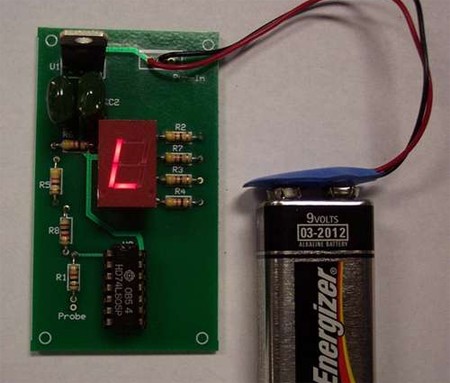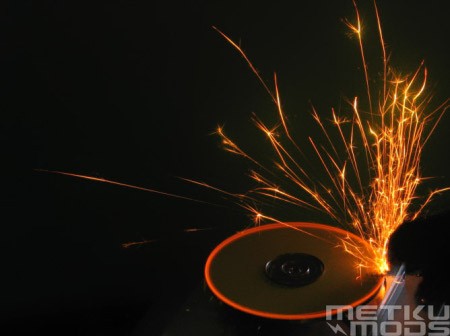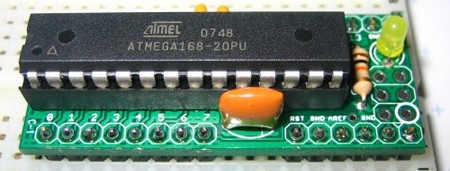[Wallace] sent in this awesome project built by [Julius Von Bismarck]. The “Image Fulgurator” is the result of mating an optical slave flash with a camera body turned projector. The result is the ability to project ghost images onto a picture being taken by anyone using a camera with their flash. Check out the demo video after the break or hit the project site for more.
Misc Hacks4191 Articles
Anti-paparazzi Sunglasses
UPDATE: Video can also be found here.
Ah, the life of the work-a-day hacker: sure, it’s glamorous, but all the paparazzi dogging your every step can get unbearably stressful. Thankfully, you have a recourse with these anti-paparazzi sunglasses. They work by mounting two small infrared lights on the front. The wearer is completely inconspicuous to the human eye, but cameras only see a big white blur where your face should be.
Building them is a snap: just take a pair of sunglasses, attach two small but powerful IR LEDS to two pairs of wires, one wire per LED. Then attach the LEDs to the glasses; the video suggests making a hole in the rim of the glasses to embed the LEDs. Glue or otherwise affix the wires to the temples of the glasses. At the end of the temples, attach lithium batteries. They should make contact with the black wire, but the red wires should be left suspended near the batteries without making contact. When you put them on the red wire makes contact, turning the lights on. It’s functional, but we’re thinking that installing an on/off switch would be more elegant and it would allow you to wear them without depleting the batteries.
[via BoingBoing]
Logic Probe Kit

Logic probes can be anything from useful to critical depending on the project, but if you don’t have one already, why not try building one? Instructables has a guide to building a logic probe using a PCB, an assorted lot of resistors, capacitors, regulators, DIP sockets, a 9V battery clip (and 9V battery), and a hex inverter. Instead of using an LED like other simple logic probes, though, this kit uses a 7 segment LED display to show whether logic high (H) or low (L). The schematic makes putting this together only slightly more complicated than snapping Legos together. Of course, the resulting device is not as versatile as a LogicPort logic analyzer, but it is still useful.
AirPiano: Touch Free IR Piano
[youtube=http://www.youtube.com/watch?v=Gh4Ovsh2DZY&hl=en&rel=0&color1=0x3a3a3a&color2=0x999999]
We were excited to learn of [Omer Yosha]’s AirPiano, but being the persnickety nerds we are, we think its more like a theremin than a piano. The device lets users play 24 different notes with a wave of the hand over the AirPiano. The “keys” are arranged in a matrix of three tiers with eight notes per tier; if the user sustains his or her hand over the AirPiano, the corresponding note is sustained.
It’s construction is relatively simple: an Arduino, several infrared sensors, and LEDs corresponding to the notes make up the device. It doesn’t have any built-in audio hardware at all, so it’s most basic use is as a MIDI controller. Still, it is essentially an unspecified input device, so it could theoretically be used for other purposes. For us, it’s fun to just watch the AirPiano in action.
Turn Your Old Hard Drive Into A Sander/grinder

[Jipa] over at MetkuMods put up an original re-use for old hard drives: make em into power tools. The tiny servo motor that drives the spindle doesn’t generate much torque, but once the drive is spinning fast enough, the inertial force of the platter is enough to make it usable for small grinding/sanding projects. The platters are re-stacked directly on top of each other to increase strength – we’d suggest a few dabs of epoxy to make em even stronger. Once stacked, a piece of sand paper is cut to size and held on by the center platter washer. [Via hacknmod]
DuinoStamp

We think that in honor of the DuinoStamp’s small size and big power, the post about it should also be small and powerful. About the size of 34-pin DIP, the DuinoStamp is a breakout board that fits in DIP sockets and is Arduino compatible. It features an ATmega 168-20PU chip, a 16MHz resonator, decoupling capacitors and more. It doesn’t come with the necessary 5V power supply or any kind of interface cable, but what do you expect for under $10?
The Great Internet Migratory Box Of Electronics Junk

UPDATE: EMSL has four more boxes ready to go. If you are in the silicon valley area, pick one up.
The Great Internet Migratory Box of Electronics Junk is essentially a virtual swap meet. A mysterious USPS flatrate box arrives on your door step filled to the brim with random electronics. You remove some pieces that you find interesting or useful. Write about them. Add some items from your own collection, and then ship it off to a recipient you deem worthy. [John Park] was kind enough to send us the box code named Rangoon and here’s what we found inside:
Continue reading “The Great Internet Migratory Box Of Electronics Junk”











